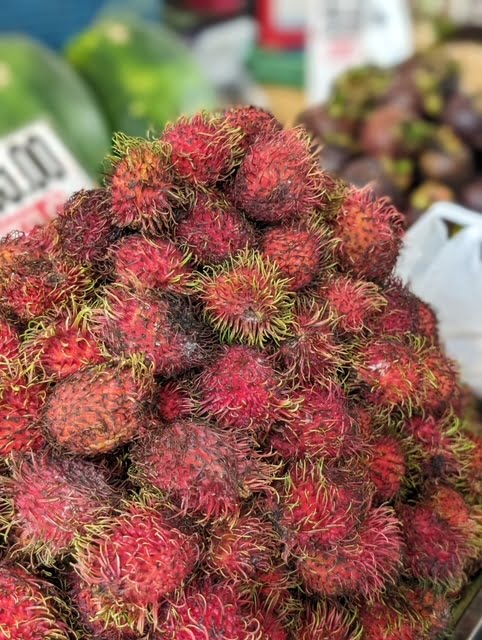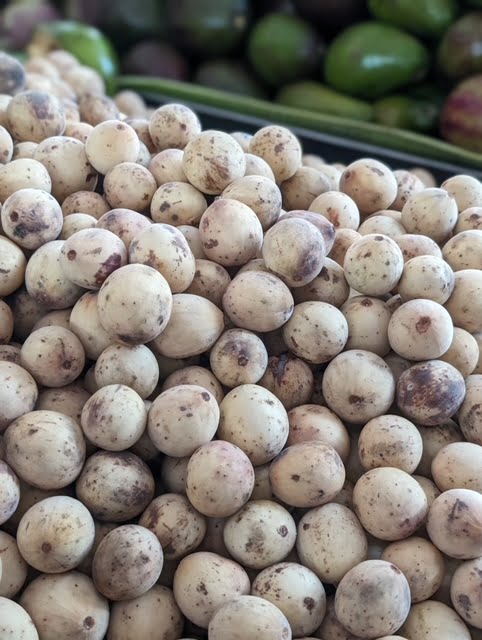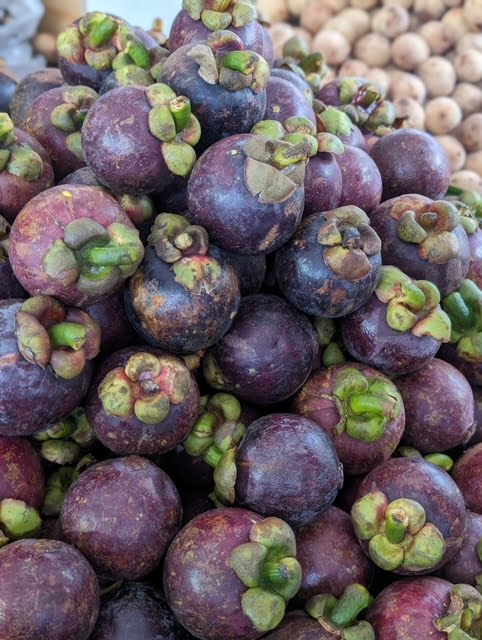The Philippines boasts of such a huge variety of fruits, there’s always something different to look forward to, depending on when you visit. Whether you’re visiting the motherland for the first time or coming home for Christmas after years of being abroad, there’s nothing like the taste of juicy pomelo that you just brought from the market or of the santol from your neighbor’s tree that fell on your side of the fence.
We’ve listed below fruits that you shouldn’t miss out on when you’re in the Philippines for the holidays, or from the wet months (June to November) to the cooler months (December to February)—as well as the best place to buy them, how they taste, and a few local secrets to enjoy eating them to the fullest. Don’t forget to check out Part 1, where we listed fruits available all year round and during the summer months of March to May.
Available during wet season (July onwards)
Santol (Cotton Fruit)
Best time to buy: July to September
Best place to buy: Available everywhere
Santol, also known as “cotton fruit,” has a thick yellowish-brown skin that is a bit cottony on the inside (thus the name). The flesh itself surrounds its seeds and is soft and very juicy—you’ll need to pop in a segment and suck flavor from the skin before spitting it out. The taste moves from sour to sweet, and it’s best eaten with salt or vinegar. Preserves, jams, and other sweets can also be made from santol.
This fruit is quite common and is available everywhere, from markets and groceries to your ambulant vendors or your local tindahan. They can be bought unpeeled or peeled, with the skin/membrane lightly sliced.
Guyabano (Soursop)
Best time to buy: August to November
Best place to buy: Quezon Province

Guyabano has soft, white flesh and an interesting mix of sweetness and tartness. You’ll usually find packaged guyabano juices in groceries, but of course, nothing beats getting it fresh.
The Quezon province in Luzon is known for guyabano, with the seaside municipality of Atimonan pushing to become its main producer. Starting 2017 with 80 hectares of farmland and 52,020 seedlings, harvests have slowly grown through the years. The best picks are from Quezon, but you can buy cut guyabano in groceries. Aside from eating it fresh or juicing it, guyabano can be turned turned into jams, preserves, jellies, candies, teas, and wines.
Atis (Custard Apple)
Best time to buy: September to December
Best place to buy: Lobo, Batangas
Also known as “sugar apple,” ripe atis can easily be pulled apart and enjoyed by picking its soft, custardy pulps and spitting out the seeds. It’s best eaten fresh, but it’s also pretty yummy after being refrigerated. The municipality of Lobo in Batangas is known as the “Atis Capital of the Philippines” and has more than 500 hectares of farmland dedicated to this fruit. If you’re heading to Lobo for a vacation in its many resorts and fine-sand beaches, don’t forget to buy a bag or two.
Rambutan
Best time to buy: August to October
Best place to buy: Laguna

The rambutan tree is very versatile and resilient, and it regularly bears fruit. Similar to the coconut tree, different parts of the rambutan tree have different uses—its bark and roots are used in the production of dye and medication. Its leaves can be used in poultices to relieve headaches.
While its outer appearance can be intimidating, the rambutan’s skin is soft and can easily be peeled. Inside is soft and juicy white flesh that’s similar to lychee. Eat it raw to get the most out of its sweet fruit juice, but you can also turn it into jam. Laguna grows the best rambutan, alongside the lanzones.
Lanzones
Best time to buy: Around October
Best place to buy: Paete, Laguna

The lanzones is a small, oval fruit with dark brown markings and is the star of its own legend, which has many iterations. According to one, the lanzones was initially poisonous, until during a bad drought, a lady appeared and pinched the fruit, leaving brown marks on its skin. Some stories say that it was the mountain goddess Mariang Makiling, some say it was the Virgin Mary, and some say it was Saint Inez, but all the same, the poison miraculously disappeared, leaving only soft, sweet, and juicy flesh that saved townspeople from hunger.
The municipality of Paete in Laguna is known to have the sweetest lanzones harvests. The best ones are soft and have more flesh than seed. Bunches are usually sold in baskets in markets and home stores.
Mangosteen
Best time to buy: August to October
Best place to buy: Davao del Norte and nearby provinces of Sulu and Zamboanga

Mangosteen has clean, white flesh and an interesting taste—when you get the fruit at its right ripeness (because it’s often always hit or miss), you’ll get to experience an exceptionally sweet, juicy flavor with hits of tangy goodness that’s refreshing on an otherwise humid day in the tropics.
While Mindanao is the main producer of mangosteen in the Philippines, the fruit itself is regularly available throughout the country, and a quick Google search will give you many online markets that can deliver a bunch to your doorstep. Weekend markets such as the Legazpi and Salcedo markets often offer them as well. If you’re heading to the nearest supermarket, ask about Dizon Farms mangosteen for quality picks.
Durian
Best time to buy: July to October
Best place to buy: Davao

Davao City is known as the “Durian Capital” and for good reason: The harvest is plentiful, and depending on the variety, the fruit has its own unique taste and texture, if you can get past the off-putting smell.
The Philippines has many different durian varieties, owing to the fact that a lot of interesting durian breeding happened in the early 1900s. It’s easy to get confused, especially if you’re standing in the middle of a market in Davao with scores of fruit kiosks around you, but you can start with the popular Arancillo, a sweet variety with a slightly bitter aftertaste. The D101 was originally from Malaysia and is also quite popular due to the very soft consistency of its flesh bursting with rich flavor. The Puyat, on the other hand, is probably what you’ve tasted if you managed to eat Philippine durian while outside the country. It’s quite a fleshy variety with a strong, sweet flavor.
There are other varieties of durian, but the best way to know which one you’d like to buy more of is to go to a public market in Davao (such as D’ Farmers Market) and ask around. Oftentimes, sellers will be more than willing to offer you a taste. In Metro Manila, the Legazpi Sunday Market offers the fruit at times, but if you really want to go all out, Mavao Pasalubong Store located in 1562 Jose Abad Santos Ave., Tondo, Manila is the best place for you to pick an entire fruit.
Want to do away with the smell but still experience durian? The fruit is prepared in many different ways and is often packed as candies or churned into ice cream.
Available during cooler months (October to February)
Chico
Best time to buy: January to February
Best place to buy: Available everywhere

Chico, also called sapodilla, has a deep, caramel-like taste. There’s a bit of grit to the texture that’s similar to pears, and it’s best eaten when quite ripe and soft. Chicos are available in wet and dry markets. A quick Google search will also pull up delivery services by the kilo.
Dalandan
Best time to buy: October to February
Best place to buy: Nueva Vizcaya in Luzon, which is known for its variety of citrus fruits

Dalandan is often mistaken as another citrus fruit called dalanghita. Dalandan, which is “bitter orange” or “Seville orange,” is sour but becomes sweeter as it matures. It’s often eaten dipped in salt. Dalandan juice is usually offered in restaurants and sold in bottles in groceries, and is a great treat especially if you have colds or are feeling under the weather. The dalandan’s peel can also be used to create marmalade.
The dalanghita, on the other hand, is a variety of Mandarin orange and is smaller and sweeter than dalandan.
Nueva Vizcaya in Luzon is well known for many citrus fruits, and dalandan bunches are sold along the highway connecting the town of Bayombong and Bambang. They’re also available in markets and groceries around the country during peak season.
Suha (Pomelo)
Best time to buy: November to January
Best place to buy: Davao
Pomelo is a citrus fruit with thick green-to-yellow skin and pinkish flesh. If you want a space in your home to smell good, peel a pomelo in it—the fresh, sweet-sour scent will chase any mustiness away.
When given time to properly ripen, pomelos are a delightfully sweet and bright fruit that will remind you of the islands when you’re far away. In the Philippines, it’s often eaten chilled as part of a salad, a snack, or a dessert. Pomelo juice is also a very popular cocktail ingredient, and is usually added to gin. Sometimes, pomelo rind is cleaned, boiled, and candied.
Davao is the best place to buy pomelos, whether in a public market or in groceries. Tell your vendor if you plan to fly them out, and they’ll put them in travel-approved crates. Pomelos are also available year-round in all parts of the country, but the best tasting ones often come between November to January.
Is your favorite fruit to eat in the Philippines not on this list? It might be in Part 1, where we listed fruits available all year round and during the summer months of March to May. Are there other fruits you want us to write about? Tell us in the comments of our Facebook and Instagram posts!
